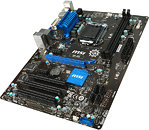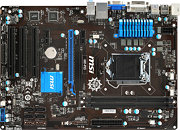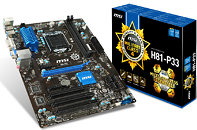Friday, August 23rd 2013

MSI Rolls Out H81-P33 ATX Motherboard
Motherboards in the ATX form-factor, based on entry-level chipsets are a rarity, but one that MSI attempted anyway. The company rolled out its H81-P33 socket LGA1150 motherboard in the 220 x 305 mm ATX form-factor, based on Intel's entry-level H81 Express chipset. The board draws power from a combination of 24-pin ATX and 8-pin EPS connectors; and uses a 6-phase VRM to condition it for the CPU. The CPU socket is wired to two DDR3 DIMM slots, supporting up to 32 GB of dual-channel DDR3-1600 MHz memory; and a PCI-Express 2.0 x16 slot (gen 3.0 is unsupported on H81 platform).
Apart from the PCI-Express 2.0 x16 slot, two other PCIe 2.0 x1 slots, and three legacy PCI, make for the rest of the expansion. The H81 Express PCH gives out two each of SATA 6 Gb/s and SATA 3 Gb/s ports, wired out as internal ports on this board. Its four USB 3.0 SuperSpeed ports are wired out as two on the rear panel, and two via header. Display outputs include one each of dual-link DVI and D-Sub (VGA). 6-channel HD audio, gigabit Ethernet, legacy PS/2 mouse/keyboard, and a number of USB 2.0/1.1 ports make for the rest of the connectivity. The board is driven by AMI UEFI BIOS, which supports Windows 8 fast boot. Expect a sub-$100 price-tag on this one.
Apart from the PCI-Express 2.0 x16 slot, two other PCIe 2.0 x1 slots, and three legacy PCI, make for the rest of the expansion. The H81 Express PCH gives out two each of SATA 6 Gb/s and SATA 3 Gb/s ports, wired out as internal ports on this board. Its four USB 3.0 SuperSpeed ports are wired out as two on the rear panel, and two via header. Display outputs include one each of dual-link DVI and D-Sub (VGA). 6-channel HD audio, gigabit Ethernet, legacy PS/2 mouse/keyboard, and a number of USB 2.0/1.1 ports make for the rest of the connectivity. The board is driven by AMI UEFI BIOS, which supports Windows 8 fast boot. Expect a sub-$100 price-tag on this one.



3 Comments on MSI Rolls Out H81-P33 ATX Motherboard
SATA3 ports are missing in the pictures :|
To me it looks like this board was designed for a higher-end chipset (H85?) due to the 2 missing SATA ports, but MSI decided to turn it into an H81 board instead. Since the pinout for all H8x chipsets are identical, it's literally a drop-in replacement.